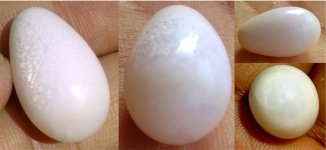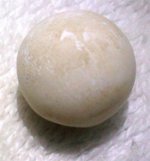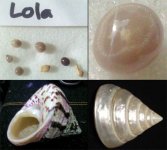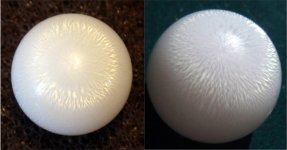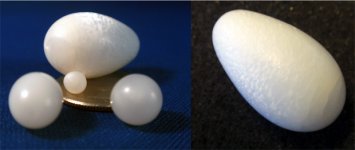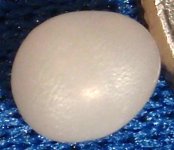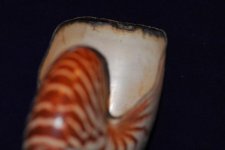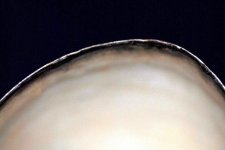SteveM
Well-known member
- Joined
- Jan 29, 2007
- Messages
- 2,113
Yet another post today, as the source material keeps coming in (and I make a very poor example of the discrete collector!).
Just to remind everyone that I am not convinced about the existence of Nautilus Pearls. But there is evidence in their favor, the nacreous/non-nacreous issue aside.
These posts are offered in an attempt to create a body of awareness for what's actually out there, while the scientific community works to get a handle on the subject.
Here is an enigma, being so large and regularly shaped (21.7ct, 11.8mm x 21.7mm). Having no idea about the anatomical origins of Nautilus pearls?should they exist?one must assume, as I have in a recent post, that the smaller, the likelier.
At first glance this screams shell. Even shell pearls, from a good shell, can display chatoyance and flame structure (see Strack on Cassis Cornuta). But upon requesting top and bottom shots then adjusting brightness and contrast, evidence of a 'swirl' appears at the bottom, such as the swirl in Pearlshooter's image cited by Tom as indicative of Nautilus Pearls. At the very least, this 'swirl' seems to support pearl status, if not (Naut?) Nautilus Pearl.
Comments?
Further speculation?
Just to remind everyone that I am not convinced about the existence of Nautilus Pearls. But there is evidence in their favor, the nacreous/non-nacreous issue aside.
These posts are offered in an attempt to create a body of awareness for what's actually out there, while the scientific community works to get a handle on the subject.
Here is an enigma, being so large and regularly shaped (21.7ct, 11.8mm x 21.7mm). Having no idea about the anatomical origins of Nautilus pearls?should they exist?one must assume, as I have in a recent post, that the smaller, the likelier.
At first glance this screams shell. Even shell pearls, from a good shell, can display chatoyance and flame structure (see Strack on Cassis Cornuta). But upon requesting top and bottom shots then adjusting brightness and contrast, evidence of a 'swirl' appears at the bottom, such as the swirl in Pearlshooter's image cited by Tom as indicative of Nautilus Pearls. At the very least, this 'swirl' seems to support pearl status, if not (Naut?) Nautilus Pearl.
Comments?
Further speculation?

